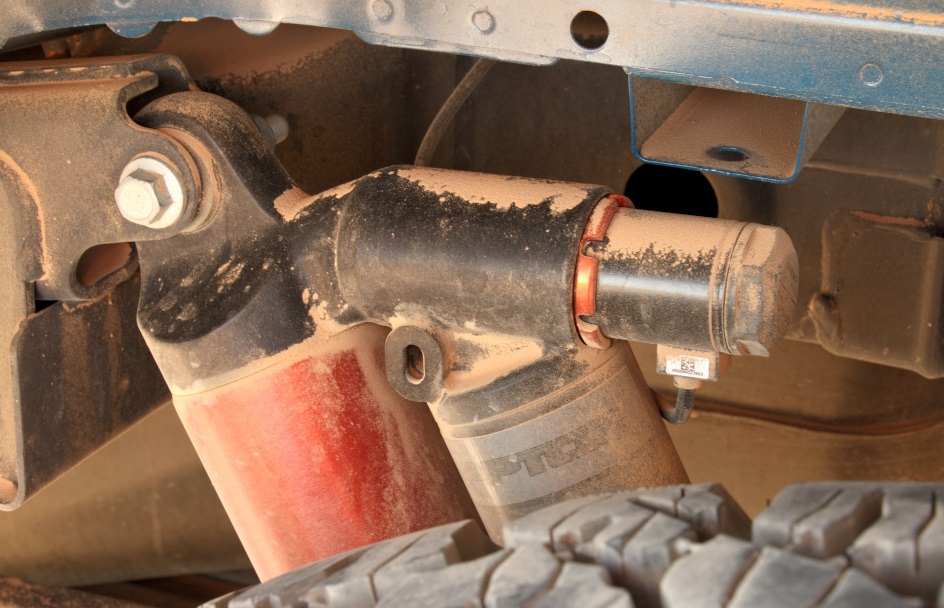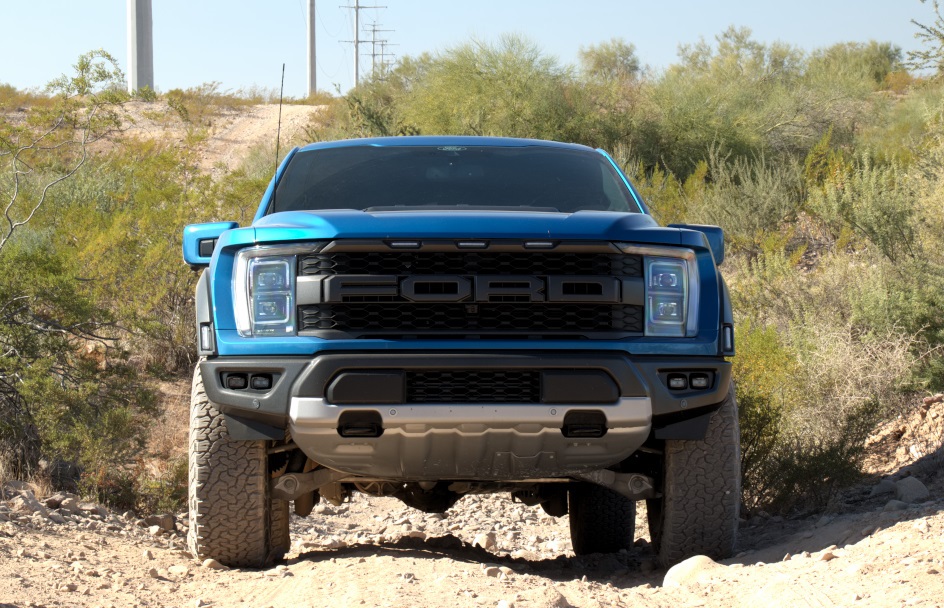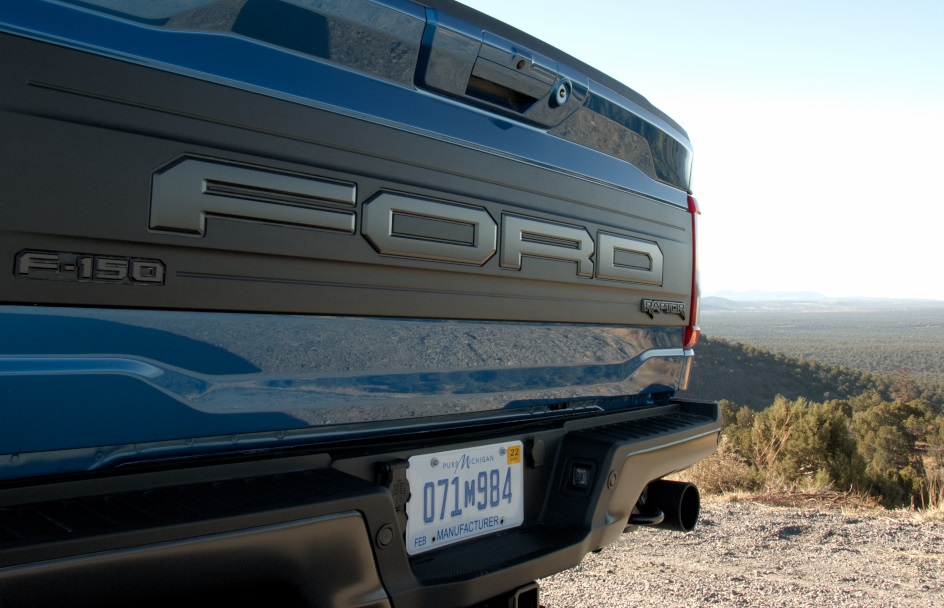The battleground on which the Big Three fought for sport truck supremacy cleared almost 20 years ago, when Ford stopped producing the F-150 SVT Lightning, the supercharged rival to the Viper-V10-powered Dodge Ram SRT-10 and the all-wheel-drive Chevrolet Silverado SS.
All was seemingly quiet for several years afterwards, but a new conflict was slowly taking shape. At first, the 2010 Ford F-150 SVT Raptor, a truck designed for high-speed off-road driving, was an industry anomaly. No other truck manufacturer pitted a model with the same focus and similar power and suspension capabilities against it.

The Raptor’s exclusive presence in its own segment remained undisturbed until the start of its third generation in 2021. Ram finally took it on with the 2021 1500 TRX (aka T-Rex), an “apex predator” with 88-inch-wide shoulders, a 702-horsepower supercharged 6.2-liter V8, and specially made 2.6-inch Bilstein Black Hawk e2 adaptive shocks.
Given my experience with the second-generation Raptor, which I used to get through a challenging trail during a Yokohama event and blast across the sand of west Texas, and the time I spent driving the TRX on-road and performing 55-mph jumps at a Nevada motorsports park, I was eager to test out the thoroughly updated and upgraded 2021 Raptor.
EVOLUTIONARY CHANGES
Ford Performance pumped up the new F-150’s styling with design changes that set the Raptor apart from milder trucks in the parking lot and help the truck keep its footing on less stable ground. The SuperCrew-only Raptor’s bold signature FORD grille features a trio of clearance lamps that make it clear that it’s more than 80 inches wide. Even without its mirrors being factored in, the Raptor measures 86.6 inches across, which means it’s nearly seven inches broader than a regular F-150 SuperCrew 4X4. The vented front fenders and bulging bedsides cover expanded front and rear track widths of 74 and 73.6 inches, respectively, which increase stability for going flat-out over rapid changes in the surface of the terrain.
A set of 17-inch cast aluminum wheels with 35-inch BFGoodrich All-Terrain T/A KO2 tires contribute to the Raptor’s 12 inches of ground clearance and 31-degree approach, 22.7-degree breakover, and 23.9-degree departure angles. Opting for the new Raptor 37 Performance Package adds sport-tuned shocks and larger 37-inch K02s on 17-inch forged aluminum bead-lock-capable wheels, expands the Raptor’s track widths, puts another 1.1 inches between it and the ground, and improves its off-road geometry. Both ends of the truck are equipped with steel bumpers so the Raptor can take hits from Mother Nature and keep charging ahead. Ford strategically designed the rear bumper so that it could position the dual exhaust outlets as high as possible to prevent them getting mangled during adventures far from civilization. Once one of the low points of the EcoBoost-ed Raptor, the exhaust system now has a much more pronounced and ear-pleasing vocal presence than before thanks to a new three-inch, equal-length layout with a built-in X-pipe, a “trombone loop,” and a pass-through muffler design.

Ford Performance went bigger with the suspension and swapped out the previous hardware for 3.1-inch-diameter anodized aluminum FOX internal-bypass shocks with Live Valve technology that uses your driving style and terrain trajectory readings to soften or stiffen the ride quality accordingly. Those are coupled with an independent double-wishbone front setup and a 5-link rear design with a Panhard rod and 24-inch coil springs. The 37-inch KO2s have their obvious benefits, but for maximum wheel travel, the 35s are the way to go. They give the new Raptor 14 inches of front and 15 inches of rear vertical space – a 25-percent improvement over the first-generation Raptor’s stats.

One thing Ford Performance left untouched was the engine and transmission. As before, the 2021 Raptor comes equipped with a 3.5-liter EcoBoost V6 that generates 450 horsepower and 510 lb-ft of torque, a 10-speed automatic, and a torque-on-demand transfer case. An electronic locker is standard in the back and can be paired with an available limited-slip Torsen front differential.
FOSTERING A DINOSAUR
Ford bundled a generous sampling of features into my Velocity Blue press loaner. By the time it was done checking the boxes for the Equipment Group 801A, Power Tech Package, Raptor 37 Performance Package, and Tough Bed spray-in bed liner, it had taken my review vehicle from a base price of $64,145 to an as-tested price of $82,080.

The Raptor arrived just in time for a romantic fall getaway with my fiancé Eli from the suburbs of Peoria to the towering fir and pine trees of Flagstaff, Arizona. Over the course of two hours and nearly 150 miles, we learned how great the Raptor’s purpose-built suspension can be on flat, paved roads. Whereas some more traditional four-wheel-drive trucks communicate imperfections in the road surface through a series of jolts, the Raptor was softspoken. Even without pushing the buttons on the steering wheel to change the steering and suspension settings, it was easy to cruise in total comfort. I had no problem keeping an eye on my speed thanks to the 12-inch digital instrument cluster. Ford Co-Pilot360 technologies such as Forward Collision Warning and Dynamic Brake Support, Pre-Collision Assist with Automatic Emergency Braking and Pedestrian Detection, and the Blind Spot Information System with Cross-Traffic Alert watched everyone around me. Eli and I had plenty of spots to hold drinks, a large center storage compartment for our snacks, and a 1,080-watt, 18-speaker B&O Unleashed sound system and a 12-inch touchscreen to play our favorite tunes, whether that was through SiriusXM, Bluetooth, or the wireless Apple CarPlay interface. One surprising drawback was the Rhapsody Blue Recaro front seats. No matter how many times I adjusted the 10-way power controls on my side, I could not configure an arrangement that was comfortable for long periods of time.
As my fiancé and I went further north on I-17, the road began to gently curve and wind through the increasingly rugged surroundings. Engaging Sport mode was the quickest way to set the Raptor up for the path ahead, but made the gas-guzzling EcoBoost V6, which has an EPA combined fuel economy rating of 15 mpg, even thirstier. To save fuel and simultaneously sharpen the Raptor’s reflexes, all I had to do was hit the button with the steering wheel icon on it to put the steering in its Sport setting. That along with the Raptor’s wide front and rear tracks helped it absolutely glide through the twists at let’s-get-there-fast speeds with a confidence-inspiring nonchalance.

JURASSIC PARKING
Once we reached Flagstaff, my fiancé and I headed to its downtown area to enjoy the cooler temperatures and the optimism and good-natured excitement of the days leading up to Christmas. After grabbing a chai and a hot chocolate from a coffee shop, we sat at an outside bistro table and sipped our drinks while we watched a local group sing carols. We decided to head to the Little America hotel once the sun started getting closer to the horizon so we could unload our luggage from the Raptor’s cavernous back row and check in. The hotel’s abundance of parking spots and a lack of vehicles flanking the open slots made it easy to fit the Raptor between the white lines on the first try. Little did I know that that casual ease was going to be short-lived.
Later that evening, wrapped in heavy coats to take on the plummeting temperatures, we ventured out for an Italian dinner at Fat Olives. I quickly realized that I had been spoiled by the hotel’s parking lot. Not only did the spots at the restaurant seem to be narrower, but the few vacancies had vehicles on both sides. Even with the help of the Raptor’s 360-degree camera package, I found it difficult to pull gracefully into a spot nose-first because its 86.6-inch width made it appear that it was close to scraping against the cars next to me. Using the backup camera and reversing into a spot was similarly frustrating. Perhaps I was being overly cautious, but I find that’s the side to err on when you’re driving someone else’s $80K halo truck. Luckily, it wasn’t long before an opening with more Raptor-friendly dimensions became available. A few minutes later, I was popping marinated oven-roasted olives and pasta into my mouth instead of spitting obscenities out of it.
The next morning, it was in the low 30s. Ice had formed on the windshield overnight. I started thawing it out before my fiancé and I got to the Raptor by taking advantage of the remote start function. Once we climbed inside, I didn’t hesitate to fire up the heated front seats and steering wheel. Given the long, serpentine drive ahead of us and the possibility of slick roads, I turned the drive mode dial to select the Slippery setting, which put the transfer case into 4A and altered a variety of vehicle parameters to handle rain and snow. I did my part by limiting my speed and the Raptor took care of the rest by keeping its grip on the road back home.

DINO MIGHT
I’m fortunate to live 15 minutes away from a vast expanse of off-road trails. Many of them are made of fine reddish dirt littered with small rocks. Although the majority of those are flat, they do have some shallow ruts and short berms here and there. Others are paths with numerous elevation changes that cross over gnarlier terrain and what appears to be a dry creek bed filled with chunks of stone smoothed by the long-lost water and the ever-present desert winds.
I started with the milder surfaces but made things more challenging by doing something I had never done in a Raptor before. The last time I drove one, I threw it into Baja mode and tore across the Red Sands area of El Paso, Texas – in a straight, level line. This time around, I was going to see how its suspension would react to rapid changes in the ground under its giant tires. Baja once again seemed like the perfect choice, especially because it sped up the EcoBoost’s throttle response. Having never taken the trails at more than 10-15 mph before, I started off cautiously and activated the front-facing camera so its real-time trajectory lines could show me what the front tires were going to contact next. The further I went, the more comfortable I got with putting my right foot down. It felt like I was in a giant video game that only I was playing. As my speed went higher, my mind and eyes had to keep up with the truck. I started feverishly looking for the next right or left I could take. The rush of excitement and adrenaline coursing through me gave me the courage to turn the wheel toward rises in the ground and rip over the peaks.

Further into the wilderness, I began making my way through brush-lined trails in the Off-Road drive mode. I had my concerns the Raptor’s oversized dimensions and the nearby greenery would leave it covered with “forest pinstripes,” but to my surprise, the truck made it through unscathed. Longer stretches gave me the opportunity to try out the standard Trail Control and Trail 1-Pedal Drive technologies. Trail Control functioned as a form of off-road cruise control and maintained my preset speed by managing the throttle and the brakes for me while I concentrated on my steering inputs. Whenever I felt as if I was carrying a little too much speed into a descent, all I had to do was pull back on the left shift paddle to feel the truck instantly slow down. Trail 1-Pedal Drive added throttle back into the mix but simplified my footwork by scrubbing off speed the second I lifted off the gas pedal. Out of concern for the Raptor’s looks and not its abilities, once I finally reached the waterless creek, I engaged Rock Crawl mode and went slowly over the shifting stones that linked the bottom of a steep decline to the rest of the natural amusement park in front of me. Aside from the mist-like red dirt that was everywhere around me, nothing touched the Raptor. My progress through one of the roughest parts of the trail was free of scrapes, bends, and dents.
I left the giant playland with the truck covered in dust and a realization. I finally not only knew but felt why people love the Ford Raptor so much. My time in the 2021 model was the most fun I’ve ever had in a pickup.
BATTLE OF THE BEASTS
There’s no mystery that the TRX can eat the Raptor for lunch on paper. But as expected in the ongoing statistical bloodsport between Ford and Ram, the Blue Oval will retaliate soon. The Raptor R is coming in the 2023 model year with a 700-horsepower version of the Shelby GT500 Mustang’s supercharged 5.2-liter V8 under its hood.
Given the industry shift toward electric powertrains, the days of the dinosaurs’ second coming are numbered. Until that man-made cataclysmic event wipes out the Raptor and TRX (at least as we know them now), they aren’t going anywhere. They’re certainly not going to make each other go extinct. The more they fight, the stronger they become.







